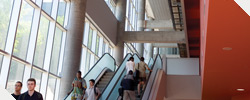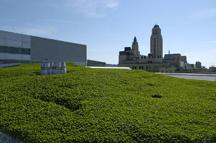Nouvelles
École Polytechnique de Montréal inaugurates its Lassonde buildings, the first "sustainable buildings" erected by an educational institution in Québec - A $104.9-million investment
 Bernard Lamarre and Robert L. Papineau, respectively Chairman of the Board and Director General of École
Polytechnique de Montréal, today officially opened the first "sustainable buildings" ever to be erected by an educational
institution in Québec: the Claudette-MacKay-Lassonde and Pierre-Lassonde buildings. Also present at the ceremony were
Honourable Jean-Marc Fournier, Québec Minister of Education, Leisure and Sport; Robert Panet-Raymond, Vice-President of the
Fondation de Polytechnique; and two major donors, Pierre Lassonde and Lorne M. Trottier. From their earliest stages, the
buildings set out to obtain LEED (Leadership in Energy and Environmental Design) Gold certification from the U.S. Green
Building Council.
Bernard Lamarre and Robert L. Papineau, respectively Chairman of the Board and Director General of École
Polytechnique de Montréal, today officially opened the first "sustainable buildings" ever to be erected by an educational
institution in Québec: the Claudette-MacKay-Lassonde and Pierre-Lassonde buildings. Also present at the ceremony were
Honourable Jean-Marc Fournier, Québec Minister of Education, Leisure and Sport; Robert Panet-Raymond, Vice-President of the
Fondation de Polytechnique; and two major donors, Pierre Lassonde and Lorne M. Trottier. From their earliest stages, the
buildings set out to obtain LEED (Leadership in Energy and Environmental Design) Gold certification from the U.S. Green
Building Council.A $104.9-million investment for an avant-garde engineering school
The total cost of the new buildings came to $104.9 million, in accordance with the project's construction budget. The Ministry
of Education, Leisure and Sport and the Ministry of Economic Development, Innovation and Export Trade invested $62.8 million
and $10 million respectively. École Polytechnique de Montréal, for its part, put $22.1 million into the project, while another
$10 million came from private donors. Meeting the LEED criteria may have meant doing things differently, but the ends justified
the means. For one thing, the buildings' energy performance is expected to be about 60% higher than the standard set by the
Model National Energy Code for Buildings.
A capital addition and confirmed environmental leadership
"The construction of the Lassonde buildings is the culmination of a collective will to give our professors and students the
chance to work in a setting specifically designed to foster technological training, cross-disciplinary exchange and advanced
research," said Polytechnique Director General Papineau, who also thanked the Québec government for its financial support and
private donors for their generosity. "For our staff, the expansion will mean consolidation of resources, since it allows us to
pool nearly all of our facilities on the same site. In other respects, the Lassonde buildings give some of our departments more
space, considerably enlarge our library and allow us to affirm our position as a leader in sustainable development. In so
doing, we're also strengthening our position as an engineering school of international calibre."
"And this is just the beginning," Mr. Papineau added with conviction. "These buildings may respond to existing needs, but other needs are already surfacing, particularly since, over the past few years, research activities at Polytechnique have increased to such a extent that our institution now ranks first among engineering schools in Canada in terms of volume of research."
Generous donors
 Claudette MacKay-Lassonde and Pierre Lassonde are two Polytechnique alumni (Class of '71) who met at the school as
students and later married. Mrs. MacKay-Lassonde, a chemical engineering graduate, had a brilliant career in the energy and
telecommunications fields and later acquired Enghouse Systems.
Claudette MacKay-Lassonde and Pierre Lassonde are two Polytechnique alumni (Class of '71) who met at the school as
students and later married. Mrs. MacKay-Lassonde, a chemical engineering graduate, had a brilliant career in the energy and
telecommunications fields and later acquired Enghouse Systems.
She died in 2000, leaving behind memories of an engineer who did an enormous amount to promoting the profession, particularly among young women. Her husband, Pierre Lassonde, an electrical engineering graduate, is today President of Newmont Mining, the largest gold producer in the world. The Lassondes donated $8 million toward the expansion -- the largest amount ever received by Polytechnique from any graduate.
 "You cannot imagine the immense pride and happiness I feel today here in this building that propels
Polytechnique into the future and confirms its leadership," declared Mr. Lassonde. "Just knowing that we were able to
contribute to this project and so benefit our alma mater gives me great joy. The donation that Claudette and I were able to
give reflects our gratitude to Polytechnique. And, since there is no greater wealth than knowledge, I think I can safely say
that our investment will be worth its weight in gold for generations to come -- and I know something about gold!"
"You cannot imagine the immense pride and happiness I feel today here in this building that propels
Polytechnique into the future and confirms its leadership," declared Mr. Lassonde. "Just knowing that we were able to
contribute to this project and so benefit our alma mater gives me great joy. The donation that Claudette and I were able to
give reflects our gratitude to Polytechnique. And, since there is no greater wealth than knowledge, I think I can safely say
that our investment will be worth its weight in gold for generations to come -- and I know something about gold!"
L orne M. Trottier, President and founder of Matrox Graphics Inc., an
internationally renowned graphics chip designer and board manufacturer with operations in the computer graphics, imaging and
video industries, donated $2 million to École Polytechnique for the construction of the Lassonde buildings. In honour of his
generous gesture, the atrium of the buildings bears his name.
orne M. Trottier, President and founder of Matrox Graphics Inc., an
internationally renowned graphics chip designer and board manufacturer with operations in the computer graphics, imaging and
video industries, donated $2 million to École Polytechnique for the construction of the Lassonde buildings. In honour of his
generous gesture, the atrium of the buildings bears his name.
Setting a good example
Michel Rose, project manager and a Polytechnique alumnus, said: "To reflect Polytechnique's expertise in sustainable
development and become a source of inspiration for future engineers, this project had to be characterized, right from its
earliest stages, by the will to minimize negative impact on the environment and curtail maintenance and development costs,
while consistently aiming to create a space conducive to learning, productivity, creativity and health. Hence the decision to
enrol in the LEED rating system."
 LEED certification has various components: sustainable site-management, water savings, energy efficiency and
atmospheric preservation, the use and re-use of materials and resources, interior environment quality, and innovation. Besides
their energy efficiency, the Lassonde buildings have other distinctive features that include recycling the heat from the
chimneys of the existing facilities; a "green roof" composed of grass and white stone; harvesting rainwater and drainage water
for reuse in the sanitation system (for a 92% reduction in the consumption of drinking water); promoting alternative modes of
transport through bike racks, electrical outlets for hybrid vehicles, and priority parking for car-poolers; the use of paint,
coverings, furnishings and doors that emit little or no volatile organic compounds or urea formaldehyde; energy-efficiency
lighting; mechanical systems using HFC-134a to minimize damage to the ozone; interior sensors that automatically shut off
lights and air conditioning in peripheral locations; and BACnet control systems allowing energy and water needs to be
constantly monitored.
LEED certification has various components: sustainable site-management, water savings, energy efficiency and
atmospheric preservation, the use and re-use of materials and resources, interior environment quality, and innovation. Besides
their energy efficiency, the Lassonde buildings have other distinctive features that include recycling the heat from the
chimneys of the existing facilities; a "green roof" composed of grass and white stone; harvesting rainwater and drainage water
for reuse in the sanitation system (for a 92% reduction in the consumption of drinking water); promoting alternative modes of
transport through bike racks, electrical outlets for hybrid vehicles, and priority parking for car-poolers; the use of paint,
coverings, furnishings and doors that emit little or no volatile organic compounds or urea formaldehyde; energy-efficiency
lighting; mechanical systems using HFC-134a to minimize damage to the ozone; interior sensors that automatically shut off
lights and air conditioning in peripheral locations; and BACnet control systems allowing energy and water needs to be
constantly monitored.
In the spirit of the undertaking, Polytechnique approached a woodworkers' organization, the Association professionnelle des ébénistes du Québec (APEQ) about transforming trees cut on the construction site into collectible furniture. One of the resulting pieces will be on permanent display in the entrance hall of the Claudette-MacKay-Lassonde building, where it will hopefully inspire tomorrow's engineers to think in terms of sustainable development and recycling. It should be noted that the project's waste management program enabled over 80% of the construction waste to be recuperated.
Multicoloured green buildings
The interior walls of the eight-storey Lassonde buildings are a tangible reflection of Polytechnique's environmental approach.
Four symbolic colours, from ground-level red (symbolizing magma) to upper-level blue (sky), via burnt sienna (earth) and
verdant green (nature), are used in an original stratified manner to create a particularly inspiring environment for
students.
132 years of development and influence
"In its 132 years, Polytechnique has become the third-largest engineering teaching and research institution in Canada," said
Polytechnique Chairman Lamarre. "The school is number one in Canada in terms of volume of research, and first in Québec for the
size of its student body and the scope of its research activities. Since 1873, Polytechnique has trained some 28,000 graduates,
many of whom have gone on to make their mark internationally; and over one-quarter of the members of the Ordre des ingénieurs
du Québec studied there. The constant addition of leading programs and infrastructures is essential if the school is to keep
its place among the world's best engineering schools. The performance of our researchers in cutting-edge fields like
microelectronics (including the urinary implant), computer-assisted surgery, orthopedic surgery, nanotechnologies, and new
sources of alternative energy (like the combustion battery) are but a few eloquent examples of the research currently underway.
All these elements represent a source of pride and prosperity for Québec."
Open house 2005
The public is cordially invited to view Polytechnique's new facilities during open house 2005, on Sunday, November 20, from 10
a.m. to 4 p.m. For details, visit www.polymtl.ca/jpo.




